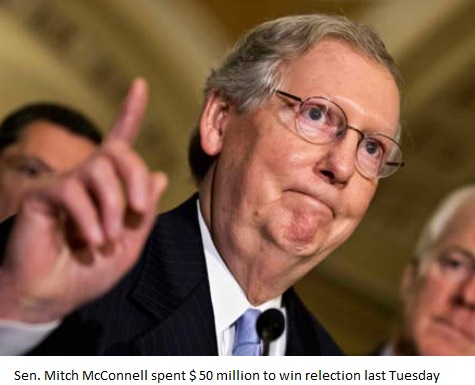CSMS Magazine
In all industrial societies, where power and wealth never cease to be glamorized, it is always the issue of inequality that remains constant in electoral politics, and the United States is by far the truest testament to this reality. The quest to flex muscles of power and arrogance dominates every sphere of modern communication. Every election cycle, billions are poured to secure an elusive bottom line: your vote. Despite the rhetoric, the perceived talk of integrity, of moral values and of honesty in public affairs, it all comes down to one common denominator: money.
In electoral politics in America, those who have the power to spend and spend big, always have a strategic edge. In other words, if you don’t have money—and lots of it, too—you stand no chance of winning. This is a mockery to social justice, a blatant disregard to millions of Americans who struggle every day just to make ends meet.
The United States Census Bureau confirms 15 % of all Americans and 21.8 % of children under the age of 18 currently live below the poverty line. This means about 50 million souls are currently classified as poor. The bulk of this number is found in two ironically distinct areas: the urban sprawled neighborhoods, which vote heavily Democratic and the extremely deprived rural counties of Appalachia and other localities, which traditionally go Republican.
In this latest cycle, nearly 3 billion dollars have been spent, not to create social programs aimed at alleviating social conditions, but to ensure the everlasting lifestyle of the rich and famous. Political analyst, Dunn Birth, asserted the United States is a “one party system split into two branches, each represents a competing fraction of the upper class.” Birth went on to say that “one is repulsively arrogant, the other is sleazily dangerous because it projects an “illusory liberalism, especially with regard to domestic policies.” Birth is not the only analyst who dwells in this observation. Millions of voters have long shunned what they perceive to be a political charade. Only 36% of eligible voters went to the polls last Tuesday, compared to 40.9 percent in the 2010 midterm elections. It is also said that only 13% of young voters between the ages of 18 to 29 cast ballots, compared to 19 percent in 2012. One has all the reasons to believe these numbers will continue to dwindle, unless there is a reversal fortune in favor of those to lodge beneath the poverty line.
To the many of those who went to the polls, there was a feeling of despair, revealing a deeply disillusioned electorate. According to CNN exit polls, six in ten voters said they were either dissatisfied or angry with both the White House and Republicans in Congress. Two-thirds of voters said the country was on the wrong track, and less than a quarter said they thought the next generation would be better off than the current generation.
It is hard to imagine an electorate gearing in favor of politicians who are completely beholden to the big business establishment, the corporate lobby and the media conglomerate. The latter has pocketed nearly 3 billion dollars in the last season. According to the LA Times, “Democrats put aside some of their remaining scruples about the new age of unlimited campaign spending and courted unions and hedge-fund billionaires for big checks to try to salvage a Senate majority…. this year, in a reversal of 2012, the big-money Democratic donors watched their investments return little on election night. Although Republicans outspent them overall, Democrats got beaten even in states like Colorado and North Carolina where they spent the same or even a little more than Republicans.”
According to the Center for Responsive Politics, a nonpartisan group that tracks election spending, Republicans spent about $1.75 billion to Democrats’ $1.64 billion.
The Brookings Institute crunched the numbers this week . The institute findings revealed the North Carolina Senate race between Kay Hagan and Thom Tillis to be the most expensive ever. One hundred and eleven million ($111 million), Brookings reported. In the chart (click on the link above), one can see how much was spent per voter in what every analyst concedes to be most expensive Senate races in US history. As you could see, Alaska, a rural state, tops the list.
This figures also show how much was spent per voter to earn their votes. These expenditures blatantly confirm the end of an era when the Democrats could use identity politics based on race, gender and sexual preference to mask their steady shift to the right and their agreement with the Republicans on ever-deeper attacks against the working class.
There is nothing popular or democratic in money politics. It has unmasked the campaign-finance-reform charade while revealing the true nature of bourgeois democracy. How representative can this democracy be when the interest of the working class is totally lost to that of the corporate elite? They have lost the moral high ground. What is needed is a counter-narrative to defeat the ever increasing arrogance that leaves no room for the working poor and their strategic interest.
Note:Dr. Ardain Isma is chief editor for CSMS Magazine. He is a scholar well versed in electoral politics. He is also a novelist. His latest book Midnight at Noon was published by Educavision. He can be reached at publisher@csmsmagazine.org .


